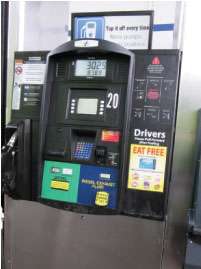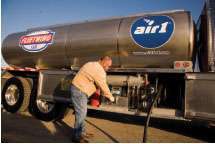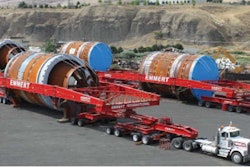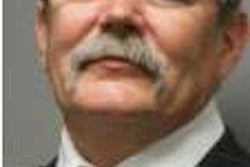Storage, handling are new fleet issues
Temperature, dilution can affect product quality
 Pilot Travel Centers has 1,100 service islands with combined diesel fuel/diesel exhaust fluid pumps where a driver can pump diesel fuel and then pump DEF from a different nozzle.
Pilot Travel Centers has 1,100 service islands with combined diesel fuel/diesel exhaust fluid pumps where a driver can pump diesel fuel and then pump DEF from a different nozzle.For fleets running 2010 and newer equipment using selective catalytic reduction to curb emissions, diesel exhaust fluid storage and handling have become issues. All fleets with such trucks need to keep their drivers informed about DEF, and bigger fleets with large terminal facilities should understand that while having an onsite tank can save big dollars on purchasing costs, it also means an extra piece of equipment to manage.
At what point should a fleet consider its own DEF tank? Chad Dombroski, director of Yara North America, recommends a 1,000-2,000-gallon storage tank for a fleet with 10 to 13 trucks, while a 3,000-4,000-gallon tank would work for a fleet with 26-40 trucks. A larger fleet with 80-160 trucks likely would need a 5,000-6,000-gallon tank.
Bill Mulligan, vice president of development, facilities and environmental compliance for Pilot Travel Centers, believes few fleets dispense the fluid exclusively from their own tanks. It costs about $225,000 to fill a DEF tank when delivered by a typical 5,600-gallon tanker, and even the largest fleets normally have their own DEF tanks only at their busiest terminals, Mulligan says.
Pilot has 1,100 service islands with combined diesel/DEF pumps where a driver can pump diesel fuel into his fuel tanks, and then pump DEF from a different nozzle on the same pump. The two purchases will show up as a single transaction on any of several national fleet credit cards, with complete information on how much was spent on each fluid and the quantity.
 A driver for Yara North America dispenses diesel exhaust fluid into a fleet’s tank. A fleet with 80-160 trucks likely would need a 5,000-6,000-gallon DEF tank.
A driver for Yara North America dispenses diesel exhaust fluid into a fleet’s tank. A fleet with 80-160 trucks likely would need a 5,000-6,000-gallon DEF tank.Pilot also offers 1-gallon and 2½-gallon DEF containers for $5.99 and $13.99, respectively, but most fleets prefer drivers purchase it in bulk from the pump because the price is far more favorable at $2.59-2.79 per gallon. DEF’s cost also raises the issue of theft: Drivers should keep their DEF containers inside the vehicle and not fastened to the back of the cab.
DEF also is relatively heavy: Two 2½-gallon containers together weigh about 50 pounds, raising at least the possibility of a workman’s compensation claim.
Temperature issues
Fleets in colder climates have additional DEF concerns, but although the fluid starts to crystalize at about 13 degrees Fahrenheit, there’s no permanent deterioration even if it freezes solid, and it can be thawed out and used.
Freezing affects only the ability to pump DEF, says Alan Smith, business development manager for Brenntag North America. “It’s not that you’ll have to replace fluid that has frozen – just that drivers won’t be able to refill their tanks until all parts of the supply system thaw out.”
An onsite DEF tank is an extra piece of equipment to manage.
Pilot’s DEF tanks are underground and maintain a temperature of about 60 degrees so the product inside doesn’t freeze or get too hot. Piping and hoses exposed to outside temperatures are wrapped in heating tape so the fluid can be dispensed even in frigid temperatures; piping at any terminal installation in colder areas needs to be equipped similarly.
Small amounts of DEF held in nonheated lines will freeze first, and a large tank filled with DEF will freeze over a long period of time. Supply lines should be heated even in southern climates where temperatures can drop below 32 degrees during winter, but a large tank there might not freeze depending on the duration of the cold weather, Smith says.
Quality concerns
Pilot periodically tests the DEF concentration in its tanks to make sure condensation has not diluted the product. Fleets with their own tanks should do the same, Smith says. While SCR equipment varies between manufacturers, most systems will dose higher to satisfy the nitrogen oxide sensor if the DEF is weakened.
Trace amounts of dilution probably won’t matter, but if DEF has high water content, drivers may encounter rapid depletion. Also, if the onboard diagnostics don’t react as they should, or if the water concentration is high enough that the system can’t compensate, high NOx will result.
Even when DEF is heated to high summer temperatures, it will last several months before degrading. At a continuous 87 degrees, it will last a year, and at a continuous 80 degrees will last two years. The fluid will last three years at a continuous 75 degrees, making underground installation prudent in hot climates, Smith says.
Tanks do not need draining unless a foreign material has entered the DEF, Smith says. The product is similar in density to water, so water normally won’t separate and lay at the bottom of the tank, he says.
To physically examine DEF, add a small sample to a clear container; the product also should be clear. “If it’s blue, yellow or has any other color tint, or has any debris floating in it, you may have a problem,” says Smith. Brenntag will conduct a full analysis at one of its laboratories if a customer requests it.











